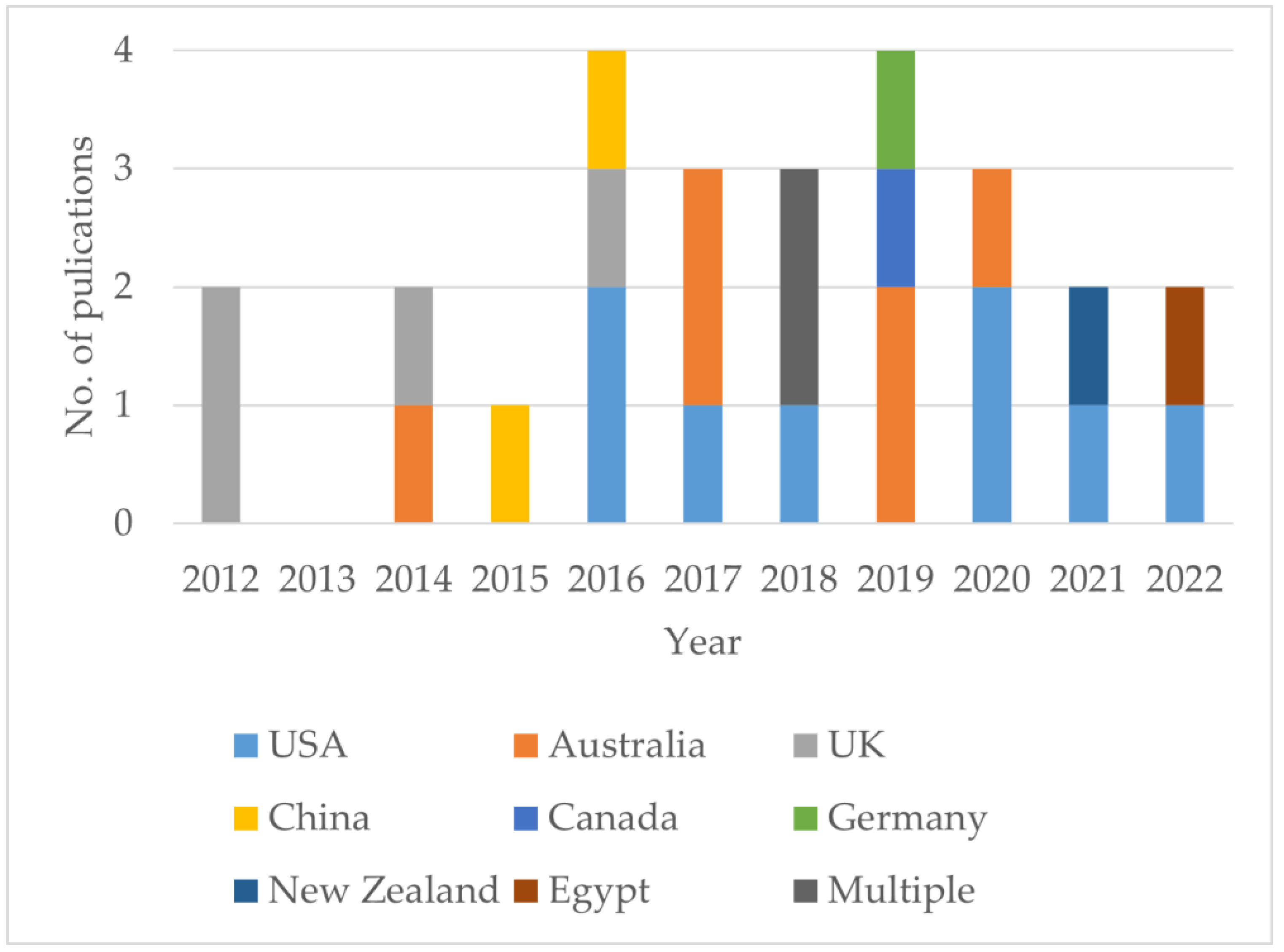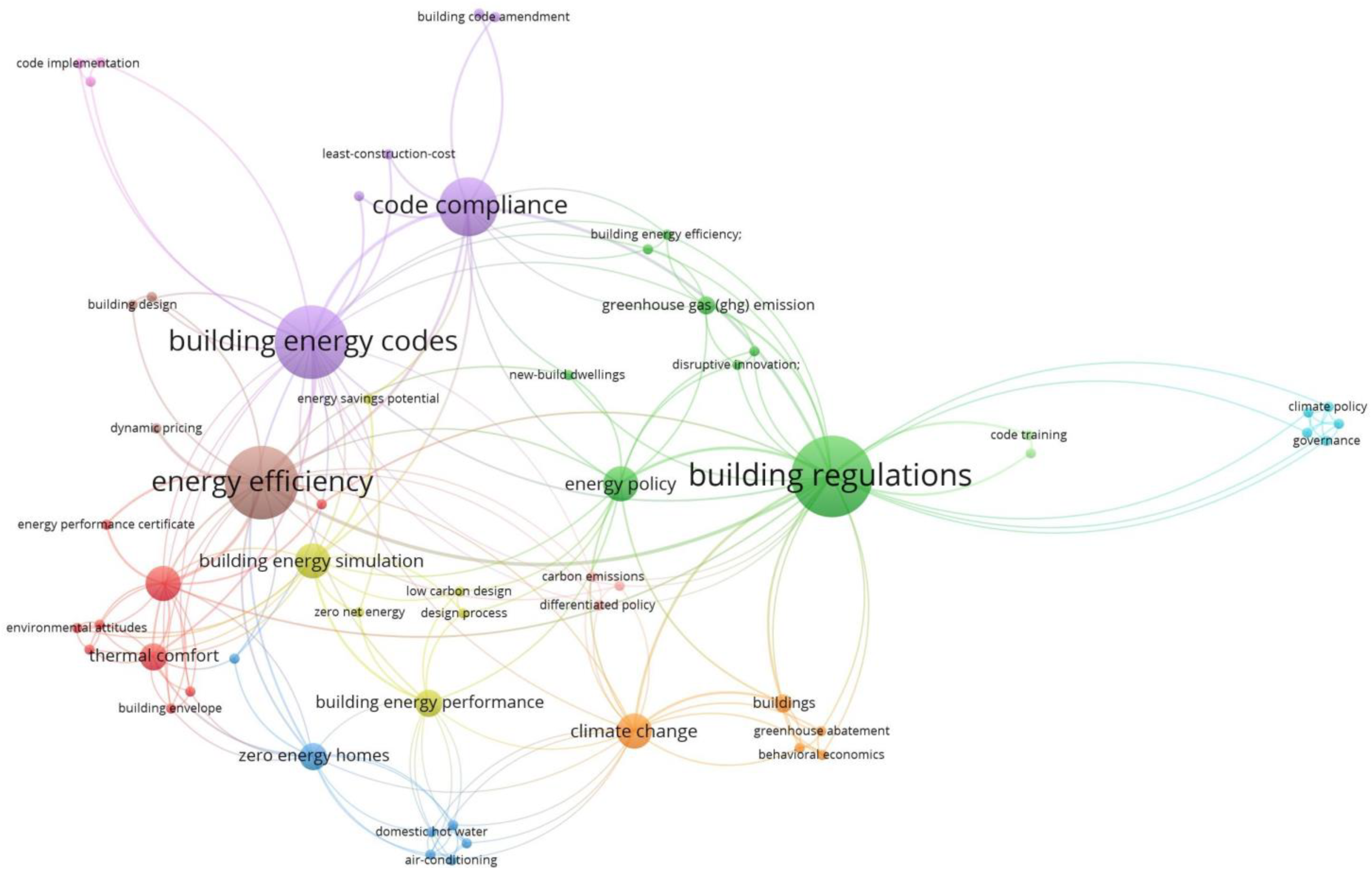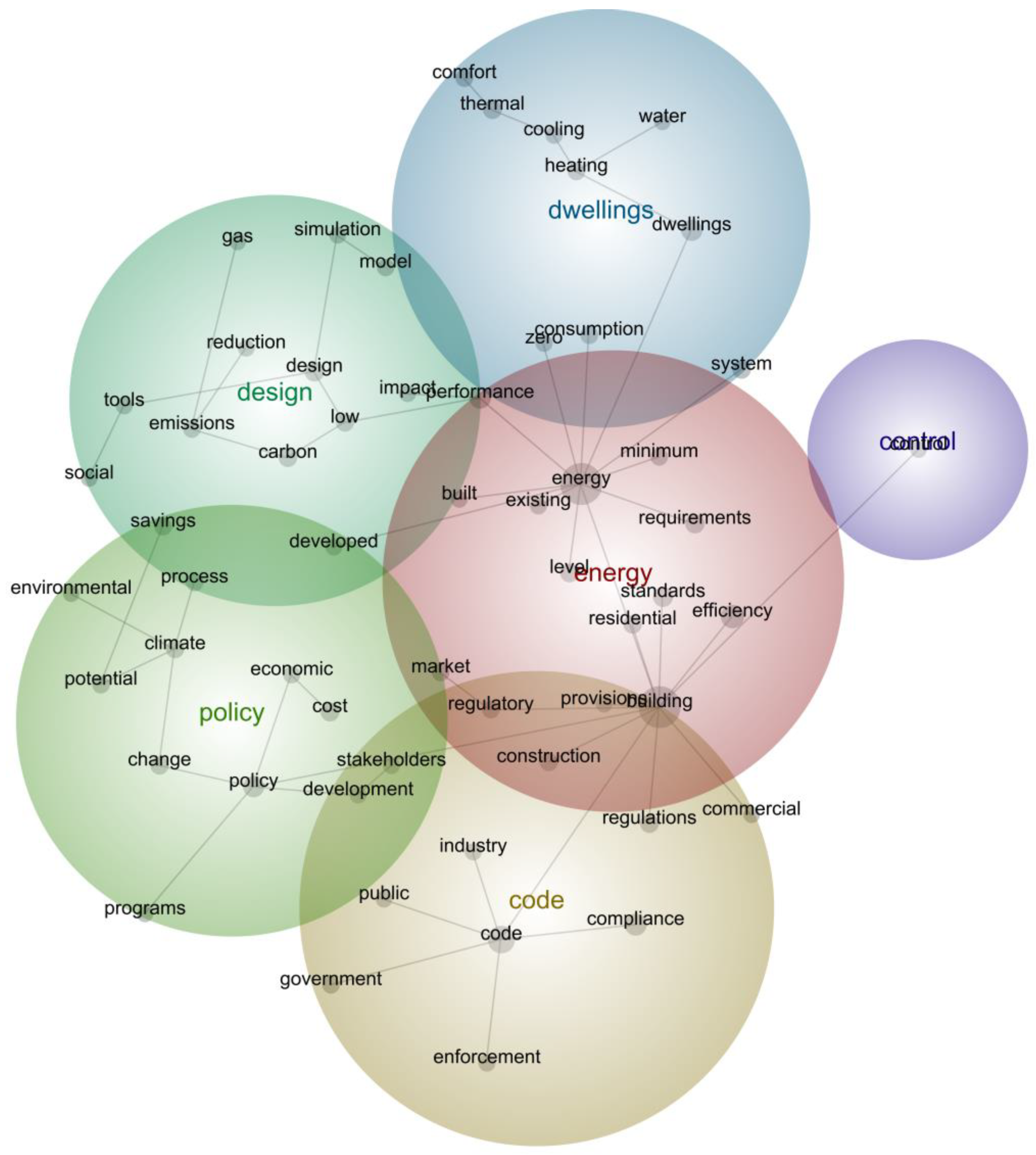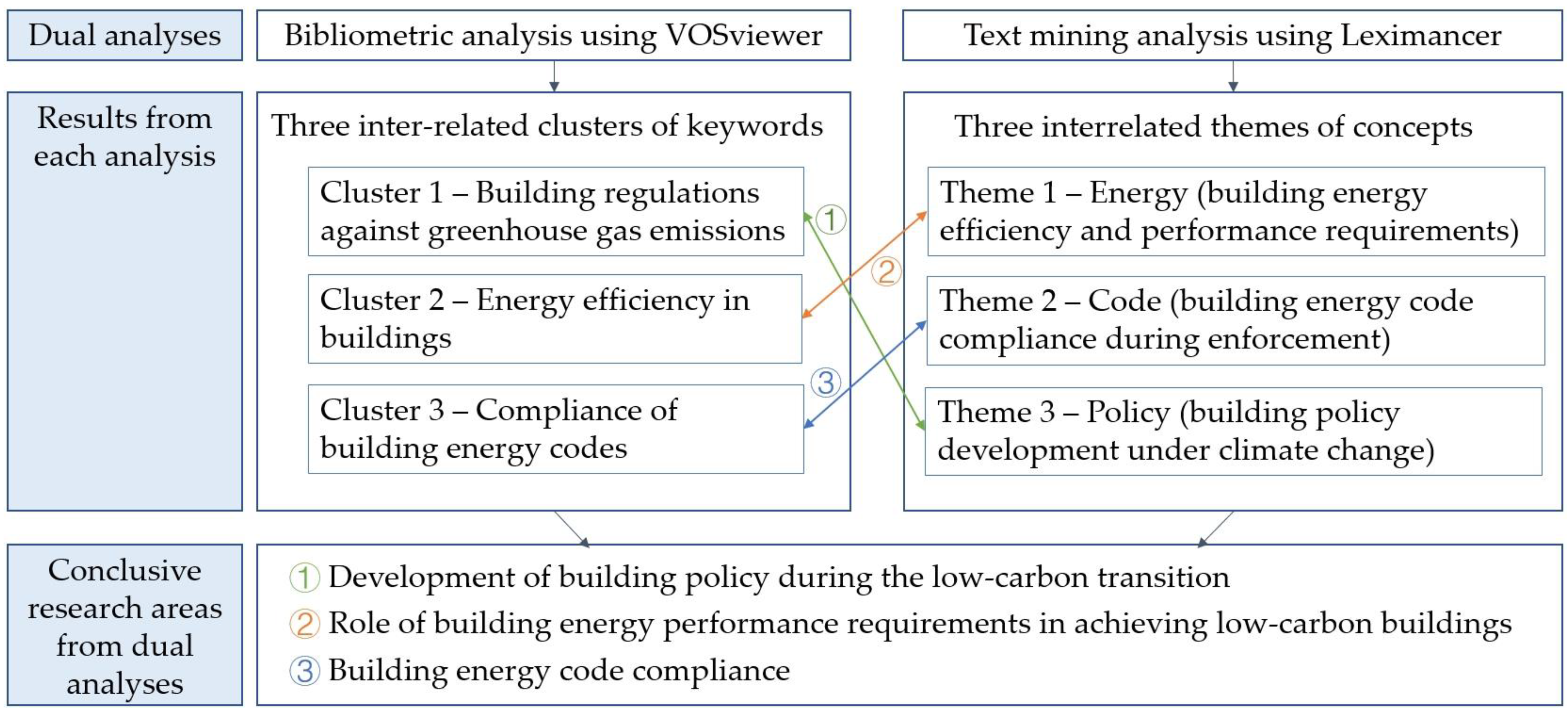A Systematic Literature Review of Non-Compliance with Low-Carbon Building Regulations
Abstract
1. Introduction
2. Materials and Methods
3. Results
3.1. Bibliometric Analysis
3.1.1. Publications Distribution
3.1.2. Keyword Co-Occurrence Analysis
3.2. Text mining Analysis
3.3. Qualitative Analysis
3.3.1. Development of Building Policy during the Low-Carbon Transition
3.3.2. Role of Building Energy Performance Requirements in Achieving Low-Carbon Buildings
3.3.3. Building Energy Code Compliance
- Status quo of building energy code non-compliance
- Influencing factors for non-compliance and strategies to enhance compliance
4. Conclusions
Author Contributions
Funding
Acknowledgments
Conflicts of Interest
References
- United Nations. Conference of the Parties (COP). Available online: https://unfccc.int/process/bodies/supreme-bodies/conference-of-the-parties-cop (accessed on 18 November 2022).
- Intergovernmental Panel on Climate Change (IPCC). Global Warming of 1.5 °C; Cambridge University Press: Cambridge, UK; New York, NY, USA, 2018. [Google Scholar]
- De Coninck, H.; Revi, A.; Babiker, M.; Bertoldi, P.; Buckeridge, M.; Cartwright, A.; Dong, W.; Ford, J.; Fuss, S.; Hourcade, J. Strengthening and implementing the global response. In Global Warming of 1.5 °C. An IPCC Special Report on the Impacts of Global Warming of 1.5 °C above Pre-Industrial Levels and Related Global Greenhouse gas Emission Pathways, in the Context of Strengthening the Global Response to the Threat of Climate Change, Sustainable Development, and Efforts to Eradicate Poverty; Cambridge University Press: Cambridge, UK; New York, NY, USA, 2018; pp. 313–445. [Google Scholar]
- Government of Canada. Details of the R-2000 Standard. Available online: https://www.nrcan.gc.ca/energy-efficiency/homes/professional-opportunities/become-energy-efficient-builder/details-the-r-2000-standard/20588 (accessed on 18 November 2022).
- City of Vancouver. Zero Emissions Buildings. Available online: https://vancouver.ca/green-vancouver/zero-emissions-buildings.aspx#zero-emissions-building-plan (accessed on 18 November 2022).
- New Zealand Government. Building for Climate Change. Available online: https://www.building.govt.nz/getting-started/building-for-climate-change/ (accessed on 1 September 2022).
- Garmston, H.; Pan, W. Non-compliance with building energy regulations: The profile, issues, and implications on practice and policy in England and Wales. J. Sustain. Dev. Energy Water Environ. Syst. 2013, 1, 340–351. [Google Scholar] [CrossRef]
- Enker, R.A.; Morrison, G.M. Behavioral facilitation of a transition to energy efficient and low-carbon residential buildings. Buildings 2019, 9, 226. [Google Scholar] [CrossRef]
- Greenwood, D.; Congreve, A.; King, M. Streamlining or watering down? Assessing the ‘smartness’ of policy and standards for the promotion of low and zero carbon homes in England 2010–15. Energy Policy 2017, 110, 490–499. [Google Scholar] [CrossRef]
- van der Heijden, J. The new governance for low-carbon buildings: Mapping, exploring, interrogating. Build. Res. Inf. 2016, 44, 575–584. [Google Scholar] [CrossRef]
- Fischer, J.; Guy, S. Re-interpreting regulations: Architects as intermediaries for low-carbon buildings. Urban Stud. 2009, 46, 2577–2594. [Google Scholar] [CrossRef]
- Chen, K. A cooperative federalism model for building energy codes. Columbia Law Rev. 2021, 121, 2119–2156. [Google Scholar]
- Pan, W.; Ning, Y. A socio-technical framework of zero-carbon building policies. Build. Res. Inf. 2015, 43, 94–110. [Google Scholar] [CrossRef]
- Moher, D.; Liberati, A.; Tetzlaff, J.; Altman, D.G.; Group*, P. Preferred reporting items for systematic reviews and meta-analyses: The PRISMA statement. Ann. Intern. Med. 2009, 151, 264–269. [Google Scholar] [CrossRef]
- Abelha, M.; Fernandes, S.; Mesquita, D.; Seabra, F.; Ferreira-Oliveira, A.T. Graduate employability and competence development in higher education—A systematic literature review using PRISMA. Sustainability 2020, 12, 5900. [Google Scholar] [CrossRef]
- Rethlefsen, M.L.; Kirtley, S.; Waffenschmidt, S.; Ayala, A.P.; Moher, D.; Page, M.J.; Koffel, J.B. PRISMA-S: An extension to the PRISMA statement for reporting literature searches in systematic reviews. Syst. Rev. 2021, 10, 39. [Google Scholar] [CrossRef]
- Moher, D.; Shamseer, L.; Clarke, M.; Ghersi, D.; Liberati, A.; Petticrew, M.; Shekelle, P.; Stewart, L.A. Preferred reporting items for systematic review and meta-analysis protocols (PRISMA-P) 2015 statement. Syst. Rev. 2015, 4, 1. [Google Scholar] [CrossRef] [PubMed]
- Pawson, R.; Greenhalgh, T.; Harvey, G.; Walshe, K. Realist review-a new method of systematic review designed for complex policy interventions. J. Health Serv. Res. Policy 2005, 10, 21–34. [Google Scholar] [CrossRef] [PubMed]
- Denyer, D.; Tranfield, D. Producing a systematic review. In The Sage Handbook of Organizational Research Methods; Bryman, D.A.B.A., Ed.; Sage Publications Ltd.: Thousand Oaks, CA, USA, 2009; pp. 671–689. [Google Scholar]
- Page, M.J.; McKenzie, J.E.; Bossuyt, P.M.; Boutron, I.; Hoffmann, T.C.; Mulrow, C.D.; Shamseer, L.; Tetzlaff, J.M.; Akl, E.A.; Brennan, S.E. The PRISMA 2020 statement: An updated guideline for reporting systematic reviews. Syst. Rev. 2021, 10, 89. [Google Scholar] [CrossRef]
- Pitt & Sherry. National Energy Efficient Building Project Report; Pitt & Sherry Consulting: Canberra, Australia, 2014. [Google Scholar]
- Harrington, P.; Toller, V. Best Practice Policy and Regulation for Low Carbon Outcomes in the Built Environment; Cooperative Research Centre for Low Carbon Living: Sydney, Australia, 2017. [Google Scholar]
- Australian Sustainable Built Environment Council’s (ASBEC); Climate Works Australia. Built to Perform—An Industry Led Pathway to a Zero Carbon Ready Building Code; Cooperative Research Centre for Low Carbon Living: Sydney, Australia, 2018. [Google Scholar]
- Pan, W.; Garmston, H. Compliance with building energy regulations for new-build dwellings. Energy 2012, 48, 11–22. [Google Scholar] [CrossRef]
- Iwaro, J.; Mwasha, A. A review of building energy regulation and policy for energy conservation in developing countries. Energy Policy 2010, 38, 7744–7755. [Google Scholar] [CrossRef]
- Vieira, E.; Gomes, J. A comparison of Scopus and Web of Science for a typical university. Scientometrics 2009, 81, 587–600. [Google Scholar] [CrossRef]
- Mongeon, P.; Paul-Hus, A. The journal coverage of Web of Science and Scopus: A comparative analysis. Scientometrics 2016, 106, 213–228. [Google Scholar] [CrossRef]
- Bilro, R.G.; Loureiro, S.M.C. A consumer engagement systematic review: Synthesis and research agenda. Span. J. Mark.-ESIC 2020, 24, 283–307. [Google Scholar] [CrossRef]
- Berry, S.; Davidson, K.; Saman, W. Defining zero carbon and zero energy homes from a performance-based regulatory perspective. Energy Effic. 2014, 7, 303–322. [Google Scholar] [CrossRef]
- Siddiki, S.; Espinosa, S.; Heikkila, T. Contextualizing Compliance in the Public Sector: Individual Motivations, Social Processes, and Institutional Design; Routledge: London, UK, 2018. [Google Scholar]
- Chanin, J.; Welsh, M. Examining the Validity of Traffic Stop Data: A Mixed-Methods Analysis of Police Officer Compliance. Police Q. 2021, 24, 3–30. [Google Scholar] [CrossRef]
- Zupic, I.; Čater, T. Bibliometric methods in management and organization. Organ. Res. Methods 2015, 18, 429–472. [Google Scholar] [CrossRef]
- Mallawaarachchi, H.; Sandanayake, Y.; Karunasena, G.; Liu, C. Unveiling the conceptual development of industrial symbiosis: Bibliometric analysis. J. Clean. Prod. 2020, 258, 120618. [Google Scholar] [CrossRef]
- Donthu, N.; Kumar, S.; Mukherjee, D.; Pandey, N.; Lim, W.M. How to conduct a bibliometric analysis: An overview and guidelines. J. Bus. Res. 2021, 133, 285–296. [Google Scholar] [CrossRef]
- Acedo, F.J.; Barroso, C.; Casanueva, C.; Galán, J.L. Co-authorship in management and organizational studies: An empirical and network analysis. J. Manag. Stud. 2006, 43, 957–983. [Google Scholar] [CrossRef]
- Glänzel, W.; Schubert, A. Analysing scientific networks through co-authorship. In Handbook of Quantitative Science and Technology Research; Springer: Berlin/Heidelberg, Germany, 2004; pp. 257–276. [Google Scholar]
- Beaver, D. Reflections on scientific collaboration (and its study): Past, present, and future. Scientometrics 2001, 52, 365–377. [Google Scholar] [CrossRef]
- Sampaio, R.B.; Fonseca, M.V.d.A.; Zicker, F. Co-authorship network analysis in health research: Method and potential use. Health Res. Policy Syst. 2016, 14, 34. [Google Scholar]
- Su, H.-N.; Lee, P.-C. Mapping knowledge structure by keyword co-occurrence: A first look at journal papers in Technology Foresight. Scientometrics 2010, 85, 65–79. [Google Scholar] [CrossRef]
- Chang, Y.-W.; Huang, M.-H.; Lin, C.-W. Evolution of research subjects in library and information science based on keyword, bibliographical coupling, and co-citation analyses. Scientometrics 2015, 105, 2071–2087. [Google Scholar] [CrossRef]
- Araújo, A.G.; Carneiro, A.M.P.; Palha, R.P. Sustainable construction management: A systematic review of the literature with meta-analysis. J. Clean. Prod. 2020, 256, 120350. [Google Scholar] [CrossRef]
- Newaz, M.T.; Ershadi, M.; Jefferies, M.; Pillay, M.; Davis, P. A systematic review of contemporary safety management research: A multi-level approach to identifying trending domains in the construction industry. Constr. Manag. Econ. 2022, 1–19. [Google Scholar] [CrossRef]
- Lima, L.; Trindade, E.; Alencar, L.; Alencar, M.; Silva, L. Sustainability in the construction industry: A systematic review of the literature. J. Clean. Prod. 2021, 289, 125730. [Google Scholar] [CrossRef]
- Chen, S.; Lin, N. Culture, productivity and competitiveness: Disentangling the concepts. Cross Cult. Strateg. Manag. 2020, 28, 52–75. [Google Scholar] [CrossRef]
- Nguyen, B.N.; London, K.; Zhang, P. Stakeholder relationships in off-site construction: A systematic literature review. Smart Sustain. Built Environ. 2021, 11, 765–791. [Google Scholar] [CrossRef]
- Ward, V.; West, R.; Smith, S.; McDermott, S.; Keen, J.; Pawson, R.; House, A. The role of informal networks in creating knowledge among health-care managers: A prospective case study. Health Serv. Deliv. Res. 2014, 2. [Google Scholar] [CrossRef] [PubMed]
- Omoregbe, O.; Hart, A. Global Trends in Heavy Oil and Bitumen Recovery and In-Situ Upgrading: A Bibliometric Analysis During 1900–2020 and Future Outlook. J. Energy Resour. Technol. 2022, 144, 123007. [Google Scholar] [CrossRef]
- Dubiel, A.; Mukherji, P. Same, same but different! New service development in the context of emerging markets: A review. Int. Mark. Rev. 2022, 39, 1226–1251. [Google Scholar] [CrossRef]
- Naukkarinen, O.; Bragge, J. Aesthetics in the age of digital humanities. J. Aesthet. Cult. 2016, 8, 30072. [Google Scholar] [CrossRef][Green Version]
- Wilk, V.; Cripps, H.; Capatina, A.; Micu, A.; Micu, A.-E. The state of# digitalentrepreneurship: A big data Leximancer analysis of social media activity. Int. Entrep. Manag. J. 2021, 17, 1899–1916. [Google Scholar]
- Wilk, V.; Soutar, G.N.; Harrigan, P. Tackling social media data analysis: Comparing and contrasting QSR NVivo and Leximancer. Qual. Mark. Res. Int. J. 2019, 22, 94–113. [Google Scholar] [CrossRef]
- Sotiriadou, P.; Brouwers, J.; Le, T.-A. Choosing a qualitative data analysis tool: A comparison of NVivo and Leximancer. Ann. Leis. Res. 2014, 17, 218–234. [Google Scholar] [CrossRef]
- Gao, J.; Yin, Y.; Myers, K.R.; Lakhani, K.R.; Wang, D. Potentially long-lasting effects of the pandemic on scientists. Nat. Commun. 2021, 12, 1–6. [Google Scholar] [CrossRef] [PubMed]
- Seyrfar, A.; Ataei, H.; Osman, I. Municipal greenhouse gas emission reduction targets: The role of building energy regulations and laws. J. Leg. Aff. Disput. Resolut. Eng. Constr. 2022, 14, 04522001. [Google Scholar] [CrossRef]
- Jacobsen, G. Improving energy codes. Energy J. 2016, 37, 93–108. [Google Scholar] [CrossRef]
- Xie, Y.; Halverson, M.; Bartlett, R.; Chen, Y.; Rosenberg, M.; Taylor, T.; Williams, J.; Reiner, M. Evaluating building energy code compliance and savings potential through large-scale simulation with models inferred by field data. Energies 2020, 13, 2321. [Google Scholar] [CrossRef]
- Contoyannis, D.; Nambiar, C.; Hedrick, R.; Chase, A.; Cunningham, K.; Eilert, P. ZNE codes: Getting there with performance trade-offs. Energy Effic. 2020, 13, 523–535. [Google Scholar] [CrossRef]
- Ahmed, K.; Apergis, N.; Bhattacharya, M.; Paramati, S.R. Electricity consumption in Australia: The role of clean energy in reducing CO2 emissions. Appl. Econ. 2021, 53, 5535–5548. [Google Scholar] [CrossRef]
- Commonwealth of Australia. Australia’s whole-of-economy Long-Term Emissions Reduction Plan. Available online: https://www.dcceew.gov.au/climate-change/publications/australias-long-term-emissions-reduction-plan (accessed on 5 November 2021).
- Doyon, A.; Moore, T. The Role of Mandatory and Voluntary Approaches for a Sustainable Housing Transition: Evidence from Vancouver and Melbourne. Urban Policy Res. 2020, 38, 213–229. [Google Scholar] [CrossRef]
- Hurlimann, A.C.; Browne, G.R.; Warren-Myers, G.; Francis, V. Barriers to climate change adaptation in the Australian construction industry–Impetus for regulatory reform. Build. Environ. 2018, 137, 235–245. [Google Scholar] [CrossRef]
- Government of South Australia. National Energy Efficiency Building Project. Available online: https://www.energymining.sa.gov.au/energy_and_technical_regulation/energy_efficiency/national_energy_efficiency_building_project (accessed on 28 April 2022).
- Council of Australian Governments (COAG). National Strategy on Energy Efficiency. Available online: https://www.energyrating.gov.au/document/report-national-strategy-energy-efficiency (accessed on 1 April 2022).
- Belusko, M.; O’Leary, T. Cost analyses of measures to improve residential energy ratings to 6 stars-playford North Development, South Australia. Australas. J. Constr. Econ. Build. 2010, 10, 48–59. [Google Scholar] [CrossRef][Green Version]
- Perianes-Rodriguez, A.; Waltman, L.; Van Eck, N.J. Constructing bibliometric networks: A comparison between full and fractional counting. J. Informetr. 2016, 10, 1178–1195. [Google Scholar] [CrossRef]
- Van Eck, N.J.; Waltman, L. VOSviewer manual. Leiden Univeristeit Leiden 2022, 1, 1–53. [Google Scholar]
- Wright, D.K.; Yoon, H.; Morrison, A.M.; Šegota, T. Drinking in style? Literature review of luxury wine consumption. Br. Food J. 2022. [Google Scholar] [CrossRef]
- Hsieh, H.-F.; Shannon, S.E. Three approaches to qualitative content analysis. Qual. Health Res. 2005, 15, 1277–1288. [Google Scholar] [CrossRef] [PubMed]
- Enker, R.A.; Morrison, G.M. Analysis of the transition effects of building codes and regulations on the emergence of a low carbon residential building sector. Energy Build. 2017, 156, 40–50. [Google Scholar] [CrossRef]
- United Nations Environment Program. Assessment of Policy Instruments for Reducing Greenhouse Gas Emissions from Buildings; Central European University: Budapest, Spain, 2007. [Google Scholar]
- Laustsen, J.; Energy Efficiency Requirements in Building Codes, Energy Efficiency Policies for New Buildings. IEA Information Paper. Available online: https://www.osti.gov/etdeweb/servlets/purl/971038 (accessed on 22 April 2022).
- Chalmers, P. Climate Change: Implications for Buildings. Available online: https://www.cisl.cam.ac.uk/system/files/documents/IPCC_AR5__Implications_for_Buildings__Briefing__WEB_EN.pdf (accessed on 2 May 2022).
- Pan, W.; Garmston, H. Building regulations in energy efficiency: Compliance in England and Wales. Energy Policy 2012, 45, 594–605. [Google Scholar] [CrossRef]
- Enker, R.A.; Morrison, G.M. The potential contribution of building codes to climate change response policies for the built environment. Energy Effic. 2020, 13, 789–807. [Google Scholar] [CrossRef]
- Garcia, J.F.; Kranzl, L. Ambition levels of nearly Zero Energy Buildings (nZEB) definitions: An approach for cross-country comparison. Buildings 2018, 8, 143. [Google Scholar] [CrossRef]
- Franke, M.; Nadler, C. Energy efficiency in the German residential housing market: Its influence on tenants and owners. Energy Policy 2019, 128, 879–890. [Google Scholar] [CrossRef]
- Guo, Q.; Wu, Y.; Ding, Y.; Feng, W.; Zhu, N. Measures to enforce mandatory civil building energy efficiency codes in China. J. Clean. Prod. 2016, 119, 152–166. [Google Scholar] [CrossRef]
- Lu, Y.; Karunasena, G.; Liu, C. Issues in compliance with low-carbon requirements in the Australian residential building industry. In Proceedings of the 45th Australasian Universities Building Education Association (AUBEA) Conference, Sydney, Australia, 23–25 November 2022. [Google Scholar]
- Burke, J.; Byrnes, R.; Fankhauser, S. How to price carbon to reach net-zero emissions in the UK. Available online: https://www.cccep.ac.uk/wp-content/uploads/2019/05/GRI_POLICY-REPORT_How-to-price-carbon-to-reach-net-zero-emissions-in-the-UK.pdf (accessed on 18 November 2022).
- Moore, T.; Berry, S.; Ambrose, M. Aiming for mediocrity: The case of Australian housing thermal performance. Energy Policy 2019, 132, 602–610. [Google Scholar] [CrossRef]
- GamalEldine, M.; Corvacho, H. Compliance with building energy code for the residential sector in Egyptian hot-arid climate: Potential impact, difficulties, and further improvements. Sustainability 2022, 14, 3936. [Google Scholar] [CrossRef]
- Nwadike, A.; Wilkinson, S. Promoting performance-based building code compliance in New Zealand. J. Perform. Constr. Facil. 2021, 35, 04021032. [Google Scholar] [CrossRef]
- US Department of Energy. Secretary Chu Opinion Piece in Times of London. Available online: http://www.geni.org/globalenergy/library/technical-articles/generation/call-for-action/usdepartment-of-energy/secretary-chu-opinion-piece-in-times-of-london/index.shtml (accessed on 15 August 2022).
- Evans, M.; Roshchanka, V.; Graham, P. An international survey of building energy codes and their implementation. J. Clean. Prod. 2017, 158, 382–389. [Google Scholar] [CrossRef]
- International Energy Agency. Policy Pathway—Modernising Building Energy Codes 2013. Available online: https://www.iea.org/reports/policy-pathway-modernising-building-energy-codes-2013 (accessed on 17 October 2022).
- Omrany, H.; Soebarto, V.; Ghaffarianhoseini, A. Rethinking the concept of building energy rating system in Australia: A pathway to life-cycle net-zero energy building design. Archit. Sci. Rev. 2022, 65, 42–56. [Google Scholar] [CrossRef]
- One Click LCA. Construction Carbon Regulations in Europe—Review & Best Practices; One Click LCA: Helsinki, Finland, 2022. [Google Scholar]
- Hu, M.; Qiu, Y. A comparison of building energy codes and policies in the USA, Germany, and China: Progress toward the net-zero building goal in three countries. Clean Technol. Environ. Policy 2019, 21, 291–305. [Google Scholar] [CrossRef]
- Vine, E.; Williams, A.; Price, S. The cost of enforcing building energy codes: An examination of traditional and alternative enforcement processes. Energy Effic. 2017, 10, 717–728. [Google Scholar] [CrossRef]
- Berry, S.; Whaley, D.; Davidson, K.; Saman, W. Near zero energy homes—What do users think? Energy Policy 2014, 73, 127–137. [Google Scholar] [CrossRef]
- Yeung, K. Securing Compliance: A Principled Approach; Bloomsbury Publishing: London, UK, 2004. [Google Scholar]
- Evans, M.; Yu, S.; Staniszewski, A.; Jin, L.; Denysenko, A. The international implications of national and local coordination on building energy codes: Case studies in six cities. J. Clean. Prod. 2018, 191, 127–134. [Google Scholar] [CrossRef]
- Shapiro, S. The realpolitik of building codes: Overcoming practical limitations to climate resilience. Build. Res. Inf. 2016, 44, 490–506. [Google Scholar] [CrossRef]
- Zapata-Poveda, G.; Tweed, C. Official and informal tools to embed performance in the design of low carbon buildings. An ethnographic study in England and Wales. Autom. Constr. 2014, 37, 38–47. [Google Scholar] [CrossRef]
- Shergold, P.; Weir, B. Building Confidence: Improving the Effectiveness of Compliance and Enforcement Systems for the Building and Construction Industry across Australia; Australian Government–Department of Industry, Science and Resources: Canberra, Australia, 2018. [Google Scholar]
- Daniel, L.; Williamson, T.; Soebarto, V. Comfort-based performance assessment methodology for low energy residential buildings in Australia. Build. Environ. 2017, 111, 169–179. [Google Scholar] [CrossRef]
- Lemprière, M. Using ecological modernisation theory to account for the evolution of the zero-carbon homes agenda in England. Environ. Politics 2016, 25, 690–708. [Google Scholar] [CrossRef]
- Wang, Y. Overview of state policies for energy efficiency in buildings. Curr. Sustain./Renew. Energy Rep. 2018, 5, 101–108. [Google Scholar] [CrossRef]
- Meacham, B.J. Sustainability and resiliency objectives in performance building regulations. Build. Res. Inf. 2016, 44, 474–489. [Google Scholar] [CrossRef]




| Category | Influencing Factors | Strategies |
|---|---|---|
| 1 Lack of knowledge | Lack of knowledge among building control officers on building energy code and its compliance requirements * [24,73,89,92] | Provide training to code officers, and invite energy code specialists to provide technical support to code officials [12,81,89,93] |
| Misuse of energy rating software by poorly trained or incompetent energy assessors ° [74] | Provide training to energy assessors [74] and establish an accreditation scheme [8] | |
| Lack of knowledge among industry practitioners on building energy code and its compliance requirements, and energy-efficient design techniques ° [7,73,74,93] | Provide handbooks or guidance to building designers; provide a training program for building practitioners [8,81,90,93,94] | |
| 2 Lack of training (linked with 1) | Lack of training provided by building control bodies to building practitioners and control officers * [7,12,73,74] | Provide training to building practitioners and control officers [81,90,93,94] |
| 3 Weak enforcement | Lack of enforcement mechanism (e.g., problems with tracking and monitoring; devolved enforcement structure; inadequate funding for sufficient enforcement of building energy codes; no penalties implementation in reality; lack of national coordination) * [8,12,74,81,89,92] | Adopt measures as recommended in [21,95], as referred to in [74] |
| Penalize any non-compliance by any responsible party with the legal requirements or hold them responsible for any oversights [76,89,92] | ||
| Inaccurate building energy rating software * [56,74,96] | Invest in software tool development [92] | |
| Flawed compliance assessment procedure * [24,73,74,92] | Introduce life-cycle approach to compliance assessment [87] | |
| Develop a checklist as a tool to assist in the evaluation of compliance of a building design [8,87] | ||
| Include comfort criteria in the energy performance assessment methodology [96] | ||
| Allow trade-offs between the efficiency levels of various building elements to achieve the prescribed whole-building energy performance [97] | ||
| More outcome-based compliance verification [74] | ||
| 4 Content and amendment of building energy code | Building energy codes are too complex, with multiple standards and programs * [92] | Simplify specification and compliance approval for buildings using advanced building materials [69] |
| Articulate a visionary objective for the building energy code (similar to UK’s zero carbon building objective or “near zero energy housing” [69] | ||
| Lock in periodic reviews of energy code provisions to address a development hiatus [69] | ||
| Allow the opinions of the building code users to count in the building code amendment process [82,94,98] | ||
| Building energy codes fail to provide incentives for going beyond minimum requirements * [12,55,92] | Introduce voluntary design benchmarks (e.g., German PassivHaus, Swiss Minergie) or building performance certificate schemes (e.g., Green Star, LEED) for energy efficiency well beyond minimum regulatory compliance levels [69,73] | |
| Short familiarization and transitional periods during code amendments * [7,73,82] | Provide clear guidance during new code updates [81] | |
| 5 Behavioral factors | Building practitioners and consumers are influenced by behavioral factors °† [8,93,94] | Use theories from behavioral science combined with the domain of public policy [8,74,98] |
| Designers and architects tend to set energy performance levels at a regulatory minimum, failing to explore alternatives (i.e., heuristics of anchoring) ° [8,69,94] | ||
| Social norms and pressures perceived by industry practitioners from comparison with peers° [8] | ||
| Social pressure obtained from consumers ° [74,93,94] | ||
| Buyers focus on up-front costs rather than lifetime operating costs (i.e., heuristics of temporal discounting) † [8,93,94] | ||
| Poor attitude among control officers toward building energy, compared to health and safety * [74,89] | ||
| Prevailing attitude of industry stakeholders toward building energy codes is apathetic and ignorant ° [8,93] | ||
| 6 High compliance costs | High costs associated with increasing the stringency of building energy codes * [93,97] | Encourage insurance institutions to develop mechanisms to consider savings from energy efficiency [97] |
| 7 Lack of awareness | Consumers’ awareness toward energy efficiency is low † [74,93,94] | Develop a guideline that conveys to end-users the effect of energy savings and thermal comfort levels [74,81,89] |
| Develop awareness campaigns and provide economic incentives to building owners or tenants [76] | ||
| Draw on lessons from behavioral science to raise consumer awareness of energy efficiency benefits [8] | ||
| Absence of awareness concerning issues of energy efficiency by the construction practitioners ° [81] | Establish environmental education to develop pro-environmental behavior and awareness [76] |
Publisher’s Note: MDPI stays neutral with regard to jurisdictional claims in published maps and institutional affiliations. |
© 2022 by the authors. Licensee MDPI, Basel, Switzerland. This article is an open access article distributed under the terms and conditions of the Creative Commons Attribution (CC BY) license (https://creativecommons.org/licenses/by/4.0/).
Share and Cite
Lu, Y.; Karunasena, G.; Liu, C. A Systematic Literature Review of Non-Compliance with Low-Carbon Building Regulations. Energies 2022, 15, 9266. https://doi.org/10.3390/en15249266
Lu Y, Karunasena G, Liu C. A Systematic Literature Review of Non-Compliance with Low-Carbon Building Regulations. Energies. 2022; 15(24):9266. https://doi.org/10.3390/en15249266
Chicago/Turabian StyleLu, Yi, Gayani Karunasena, and Chunlu Liu. 2022. "A Systematic Literature Review of Non-Compliance with Low-Carbon Building Regulations" Energies 15, no. 24: 9266. https://doi.org/10.3390/en15249266
APA StyleLu, Y., Karunasena, G., & Liu, C. (2022). A Systematic Literature Review of Non-Compliance with Low-Carbon Building Regulations. Energies, 15(24), 9266. https://doi.org/10.3390/en15249266








